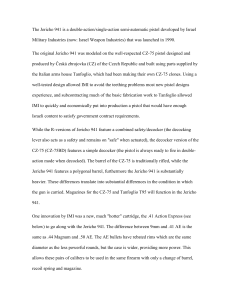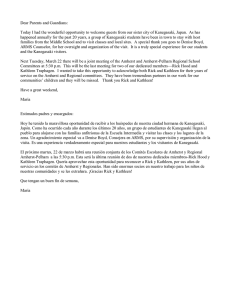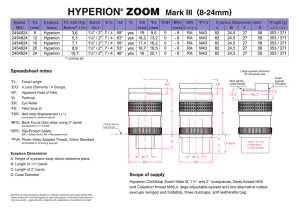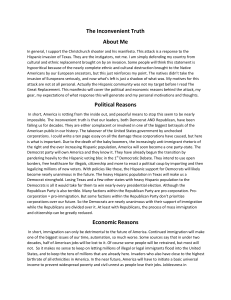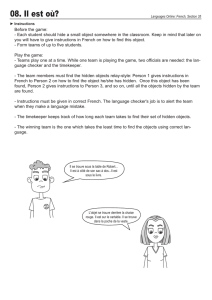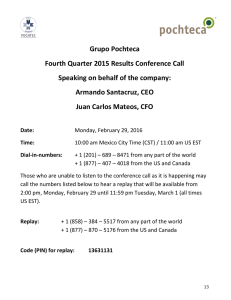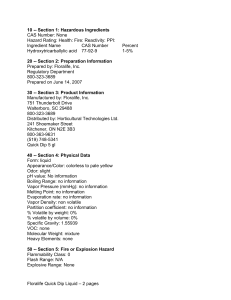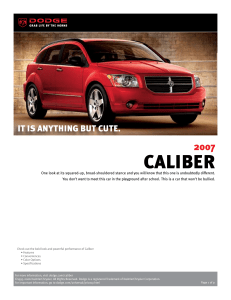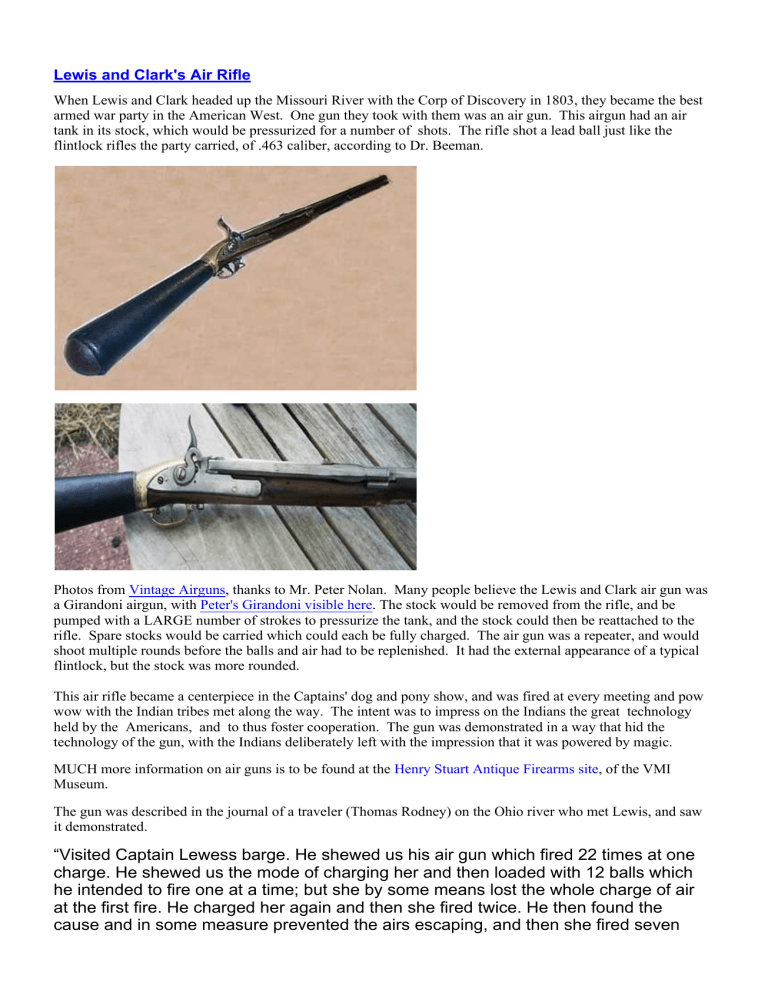
Lewis and Clark's Air Rifle When Lewis and Clark headed up the Missouri River with the Corp of Discovery in 1803, they became the best armed war party in the American West. One gun they took with them was an air gun. This airgun had an air tank in its stock, which would be pressurized for a number of shots. The rifle shot a lead ball just like the flintlock rifles the party carried, of .463 caliber, according to Dr. Beeman. Photos from Vintage Airguns, thanks to Mr. Peter Nolan. Many people believe the Lewis and Clark air gun was a Girandoni airgun, with Peter's Girandoni visible here. The stock would be removed from the rifle, and be pumped with a LARGE number of strokes to pressurize the tank, and the stock could then be reattached to the rifle. Spare stocks would be carried which could each be fully charged. The air gun was a repeater, and would shoot multiple rounds before the balls and air had to be replenished. It had the external appearance of a typical flintlock, but the stock was more rounded. This air rifle became a centerpiece in the Captains' dog and pony show, and was fired at every meeting and pow wow with the Indian tribes met along the way. The intent was to impress on the Indians the great technology held by the Americans, and to thus foster cooperation. The gun was demonstrated in a way that hid the technology of the gun, with the Indians deliberately left with the impression that it was powered by magic. MUCH more information on air guns is to be found at the Henry Stuart Antique Firearms site, of the VMI Museum. The gun was described in the journal of a traveler (Thomas Rodney) on the Ohio river who met Lewis, and saw it demonstrated. “Visited Captain Lewess barge. He shewed us his air gun which fired 22 times at one charge. He shewed us the mode of charging her and then loaded with 12 balls which he intended to fire one at a time; but she by some means lost the whole charge of air at the first fire. He charged her again and then she fired twice. He then found the cause and in some measure prevented the airs escaping, and then she fired seven times; but when in perfect order she fires 22 times in a minute. All the balls are put at once into a short side barrel and are then droped into the chamber of the gun one at a time by moving a spring; and when the triger is pulled just so much air escapes out of the air bag which forms the britch of the gun as serves for one ball. It is a curious peice of workmanship not easily discribed and therefore I omit attempting it.” Animated views of the firearm and and its firing (three seperate animations) are to be found at the Animations page of the Discovering Lewis and Clark site, along with much more information about the Core of Discovery. The air gun was described as being "of the Girandoni type", referring to an Austrian maker of similar air guns, although some believe that it was a Girandoni, sold by a U.S. dealer. More information and illustrations on the Lewis air gun and Girandoni type air guns are on the site of Robert D. Beeman PhD. The smaller, the deadlier We wrote once about miniature spy cameras, now we are going to up the stakes. James Bond types not only need to inconspicuously take pictures, they also need to inconspicuously kill people. When given "license to kill", it's still better to do it with as little fuss as possible. We'll start with the "largest" of the bunch, more conventional pistols, which are still portable enough to be hidden in "plain sight". Graciously provided by Alan Trigger, from "Little Gun" collection in Belgium, these pictures remind us of the era of Victorian (and Wild West) engineering, sometimes more deadly when we care to admit. 1869, Brass Knuckle-Pistol Combo "Apache": (see more pictures here) Similar thing has been patented in US in 1904: Military Knuckle Knife, used in WWII looks also quite sinister: Derringer-Uberti, Italy (caliber .38) - Gorgeous little Derringer "Maverick": Reel J. J. was made from 1846 to 1893 - "Coffee Table" Deprez (purse) gun, very stylish: (caliber 7mm) Pocket Watch Pistol Made in England, very rare model, 0.3 caliber. "Gentlemen, let's synchronize our watches" Another pistol-watch: The Pistol Ring "Femme Fatale" .06 caliber. Also made in England, in 1870. Gives a whole new meaning to nuptial agreements: Classic Pen Pistol How many times we read about this in pulp fiction? Here is how this little deadly device looks: Pistol inside a lock American-made, controlled by two keys, caliber .38. "You can lock me in, but you're gonna regret it" More after the jump: Saddle-clasp pistol, 1775 The wildest western accessory I've seen so far: Single-shot Threaded Bolt Colt .12 caliber - what kind of circumstances would prompt the use of this one? Walking Stick Gun .38 caliber. From Professor Moriarty's wardrobe: The Crucifix Gun 9mm caliber. Aahh...saving these souls from the plight of their mortal coil. May they rest in peace, as I will definitely pray for them... More influential religious types carry even more advanced system: The Whip Pistol Caliber .52, made in England. Kinky. Strange mini-gun of unknown manufacturer The Hook Pistol! The trigger is in the eye of this hook! Probably the smallest gun on record - The Inkwell Gun Japanese-made, in 1850, Caliber .36 Pocket Knife Pistol Smoking Pipe Gun .22 caliber. Property of Sherlock Holmes: Booby-trap Pistol When you need to catch someone unaware. Attach one end of a string to the door and another end to the gun. The poor guy opens the door and... BOOM! Gun inside the suspenders US-made, caliber .32 for the Bachelor Club: (or when you starting to lose in poker) The Cigarette Lighter Gun Zippo lighter, very classic, very cool - The Key Pistol, 1822 Pull the little ball at the end and shoot. Caliber .22 These guns may be smaller, but you'll be just as dead "Do not move while I destroy you, Mr, Bond" In the first part of this series we saw some vintage miniature weaponry, showcasing the ingenuity and craftsmanship of pistol makers, and the deadly intent of spy technology in the past couple hundred years. Modern spy-tech is definitely more deadly and efficient, but the information about it is pretty scarce (for obvious reasons). On this page we'll see some examples of the modern weaponry, and the weirdest of vintage mini-guns. Many images were graciously provided by Alan Trigger, from "Little Gun" collection in Belgium. Officially the Smallest Pistol in the World, Manufactured Today Made in Switzerland (of course!), by SwissMiniGun company. On their site you can see illustrations of this revolver in real size: no bigger than 5.5 cm (2.16 inches). Even though you can put this gun on your key-chain, it's a deadly weapon. It fires 2.34mm bullets, with the killing range of 112 meters. SwissMiniGun can also be more expensive than a luxury Swiss watch. In fact, one of the offered models is made in hand-engraved 18k gold, encrusted with the choicest diamonds (price starts at $50,000) - (images credit: SwissMiniGun) Note to collectors: SwissMiniGun can not be imported into the USA due to present regulations, however, it's readily available in Canada. Other Modern Spy Guns Seecamp LWS 25 (or LWS .32 - same size, larger caliber) model is also very small: It is available for purchase through certain dealers, and can also be embellished with custom engraving (if you insist on making a deadly object as beautiful as possible) - (image credit: Seecamp) Flashlight Shotgun Currently produced by ARES Defense Systems. "A grenade-style pin removes the safety, and the flashlight fires a .410 shotgun round out the back when a button is pressed." (image credit: ARES Defense Systems) Cellphone Gun a very mean variety of covert weaponry, hunted by security forces around the world. "Hitting the 5, 6, 7 and 8 buttons on the phone fires four .22 caliber rounds in quick succession." (image credit: virginmedia) Miniature Firefighter's Pistol Getting back to vintage-tech, this extreme example of palm-sized, spring operated pistol hails from the bad old days of prohibition and gangsters - when arson was the main occupier of the firemen. Max Johnson sent us the photos, adding that such guns "were widely used by Chicago firemen... My dad's dad had one he got from a friend who was one of these firefighters" - (image credit: Max Johnson) Here is David Kucer's Smith & Wesson (image credit: littlegun.be) Pretty cool Derringer DA 38 (caliber 9mm!) Kolibri by Pfannl Franz - Vintage key-chain-sized gun (2.7mm caliber) This is a fascinating model, much sought by collectors: (image credit: littlegun.be) Deadly miniatures from French history Other miniature pistols and guns - this time a collector's scale models, but fully functional. They are mostly creations of Michel Lefaivre of Paris, France (see more here) P08–Luger (a working miniature). The 2/5 scale model represents about 600 hours of precision work: The miniature craftsmanship and detail is often astonishing: A French rifle, model 1874 - "Gras" fully functional at 1/4 scale, along with its bayonet: (images credit: Michel Lefaivre) The following is a series of strange-looking small pistols and other guns, which we hesitate to identify without consulting with collectors: (let us know if you aware of any of these models) Here is a very endearing little piece: Pocket Pistol from 19th century France: (image credit: Trevino) Another incredibly bizarre mini-gun: Ten-Barrelled Pin-fire Pistol - again, France 19th century: (image credit: Trevino) A Noon-Day Gun If your thing is to greet the mid-day with an exquisite cannon blast, then take a look at this: "A miniature brass cannon barrel and brass-mounted adjustable circular magnifying glass fixed to a circular white marble base", all only 23 cm in diameter: Knife Pistol by Unwin & Rodgers, England, circa 1830 - (more info) (image credit: aaawt.com) Here is a key flintlock from the 18th century. Very ornamental, almost fantasy-like piece: (length: 23 cm) How about a portable cannon? Not much is known about this curiosity: A deadly handshake: Glove Pistol (must be pretty awkward to carry it around) Most beautiful gun powder flask Gun powder flask with sundial (16th century) - more info It is also a compass and a watch - only 10 cm in diameter. Made in Germany, in 1590...imagine that. Spy Guns of the Future Past We just have to mention miniature rayguns from the future that never was. Look at these Steampunk Rayguns creation of antiMichael from Make:Blog (image credit: antiMichael) And a real beauty: The Distracted Alchemist's Ray Gun: (image credit: Andrew Beal) M1868 Papal States Remington (Pontificio): GENERALLY: This early Remington Rolling Block is a copy of Remington’s M1867 which was built under license by both Wesley Richards in Birmingham, England and by Emile & Leon Nagant in Liege, Belgium. It is very close in both dimentions and cartridge to the M1867 Swedish Remington and M1867 Norwegian Remington Rolling blocks. It was made in small quantities for the Papal States (the Vatican, which was autonomous at the time) prior to their absorption into Italy and Italian unification in 1870 after the defeat of the Vatican forces in the battle at Porta Pia in Rome. Many of the captured rifles were re-issued to the Italian Army and later, after the widespread fielding of the M1870 Vetterli, most were issued to Italian allies in North Africa, accounting for the scarcity of these rifles. PHOTO: The pictured rifle above is the M1868 Papal States Remington Infantry Rifle. DISTINGUISHING CHARECTERISTICS: The M1868 Papal States Remington rifle is chambered in a cartridge unique to the Vatican, the 12.7 x 45, but which is very nearly the American .50-70 caliber. The butt plate is flat rather than curved as American Remingtons of the period were. Markings are distinctive to this rifle including, on the left side of the receiver, "Brevet Remington" (Remington’s Patent) Liege proof marks on the barrel, and stamped into the ,left side and, on the top of the knoxform, the wholly dispositive Papal States proofs of consisting of St. Peter’s two "crossed keys" under the Papal tiara. No other rifle carries these markings. MISC NOTES: The rifles are 51 inches in length but this model was also built as an Artillary Mousqueton and Gendarmerie Mousqueton. MORE "Brevet Remington" (Remington Patent) (Please follow the link below to the Gendarmerie model for excellent pics of the "E.M. & L Nagant A Liege" markings) The famed "Crossed Keys" of St. Peter. Totally dispositive of the identity of this Rifle. The E. L. Nagant markings ahead of the Serial Number. Also, below, markings of the rifle having passed Belgian proofing. The rifle has BOTH bayonet lug and tenon on the right side, as well as a supporting lug on the left side of the barrel Additional Belgian Proof markings, and Vatican Acceptance Stamp Manufacturer's markings on the barrel. Bore markings (12.4 mm) on the bottom of the barrel along with manufacturing and acceptance stamps. Cartouche evidencing the rifle being a gift of European Catholics to the Vatican forces. Anti Garroting Belt Gun - Approx. .50 cal.; 1.5” barrel. - Possible reproduction in very good condition. - Crisp mottled gray metal; working. This design reportedly originated as a French belt gun, worn pointing backwards, to thwart garroting thugs. These miscreants worked in two man teams, the 1st slipping a garrote around the throat of the victim, and hoisting him back to back like a sack of potatoes while the associate explored his pockets & relieved his of his valuables. With this handy device mounted on the belt & a string attached to the trigger running up his sleeve, the assaultee could ruin the day of le mugger. - Original examples are quite rare, and I suspect this one is likely a non-period reproduction. It differs in design & construction from supposedly authentic examples I have examined. But hey, who knows? Firearms Curiosa by Wynant, p.152. Tony Saucier collection. - [8tsm112] - non-ffl - (est.250 to 500) Very odd flobert .22 pistol. - Good condition. - I've never seen anything like this, and some VERY knowledgeable guys I asked haven't either. Single shot pistol; open breach suggest it may be for the very weak .22 flobert rimfire ctg. (DO NOT think about shooting modern .22 ammo in this; I expect you'd get a cartridge case lodged far up your nostril when you dropped the hammer, and that would be the BEST possible outcome). - Gray metal with some pits; marked “RIFLED BARREL 22” on the left side; “49” on right; and…. uh…. errrr… What can I say? - [8wmop-2] - antq – Stocked percussion pistol. - .58 cal.; 12” round 3 groove rifled barrel. - Assembled. - Previously sold through another auction company's catalog optimistically listed as “possible prototype”. Current owner now probably more accurately describes it as a “hell of a gun,” (emphasis uncertain). - Light gray metal with dark spotting; barrel breech marked “V” & “P”; lockplate markings are almost too strong & include “SPRING / FIELD / 1852” behind hammer, with eagle over U.S. forward of hammer. Captive ramrod. Light patina brass furniture. Very good wood is likely more recent than period of use. - [8dsk-13] - antq - (est.750 to 1500) Ketland & Co. brass barrel flintlock blunderbuss - London marked - Oct./round 14.5 brass barrel flares to 1-1/8 inside diameter at muzzle - Good condition - Light patina w/ minor dings on barrel, marked LONDON with TK, crown P & crown V proofs. Gray lock has light pitting, marked KETLAND / & Co. Some light engraving on brass furniture. Stock has been broken at wrist & repaired, large sliver missing at top of lockplate, crack on right side of forend. - [mf-9jany] - antq - (est.2000 to 5000) Dag blunderbuss handgun - 8” barrel w/ 1.75” diameter muzzle bell. - Brass oct./round barrel with extensive simple geometric pattern decoration. Working; missing triggerguard. Sound stock showing age & use marks. - [8rgmo81] - antq - (est.300 to 600) German - Parlor pistol - 6 mm Flobert - Excellent condition; 10” barrel.. - 90% bright nickel; working; fine grips. Do not fire w/ any type modern ammo. - Tony Saucier collection. - [8tsm114] - s/n FD217 antq - (est.50 to 100) Bergman - M1896 No. 3 - pistol - 6.5 mm - About good condition. - Patina metal w/ remainders of dull blue. A bit of light roughness on left side; right side has scattered moderate to deep pits on barrel & sideplate. Sound moderately worn checkered wood grips. - Mfg. 1898. Tony Saucier collection. [8tsm017] - s/n 3041 - antq - (est.750 to 1500) Hijos de Calixto Arrizabalaja - Jo Lo Ar - pistol - 9 mm - Missing lever. Otherwise very good. - Fairly smooth metal w/ mixture of patina, gray & blue; good markings include 1924 date. Light wear to sound grips. - Tony Saucier collection. - [8tsm005] - s/n 29941 - C&R ffl - (est.125 to 250) Star - Super A - Air Force pistol - 9 mm Largo - Appears as new in box. - About 100% matte black finish; markings include air force seal reading “Armas Tropas Aviacion / Ejercito del Aire”. Wood grips w/ sharp checkering. Import marked. Spare mag. In slightly tattered box marked “EJERCITO del AIRE”, numbered to a different gun. With spare mag & old Spanish language Star literature. - Air Force marked. Tony Saucier collection. - [8tsm180] - s/n 355188-05581 - FFL - (est.200 to 400) Star - Model S - Air Force pistol - 9mm Corto (.380 acp) - With box in excellent condition. - Extremely crisp; area of flaked blue at top left rear slide & some speckling on backstrap; overall 97% finish with no signs of wear. With Spanish manual for “Nuevo Modelo 'S' 1941”. - Air Force marked, in original numbered Air Force box, 2 matching magazines, Mfg. 1941. Tony Saucier collection. - [8tsm183] s/n 5929 - C&R ffl - (est.150 to 300) Pieper Bergman - 1910/21 - Danish military pistol. - 9 mm Bayard Long - Metal is excellent; grips probably replaced. - Crisp metal w/ 98% soft blue; a few tiny rough spots; excellent markings include Pieper Liege address & “M1910/21”. I suspect the well made old appearing smooth wood grips are replacements. - Danish. Tony Saucier collection. - [8tsm018] - s/n 7248 - C&R ffl - (est.800 to 1400) Enfield - Mk. VI - British military revolver - .455 cal.; 6” barrel. - Excellent condition. - 97% military finish; gray on barrel & cylinder & more black on frame. Numerous military markings. Sound worn grips. Excellent bore. Still in original chambering. - Tony Saucier collection. - [8tsm046] - s/n 423831 - C&R ffl - (est.350 to 700) Mexican sword in parfleche Native American sheath. - 32” blade. - Brass handguard features eagle & snake, with lion head pommel; plain wood handle. Probably a composite era artifact, as explained in the collection notes: “Ca. mid-1800's to late 1800's Mexican sword. Parfleche sheathe with trade cloth added after falling into Indian hands. Belled fringe and excellent tiny bead work, possibly Crow, probably the latest addition to this excellent all around artifact. Extra fine condition.”- collection notes. - [8fli-111] - Floyd Lyerla collection. – Crow beaded knife sheath. - “Crow seed beaded knife sheath. Pleasing multi color design with basic crow pink background. Variation of the dragonfly design. Fully fringed down one side and stiffened on back side with hide glue. Made from Native tanned deerskin, 1st half 1900's, South Dakota.” collection notes. - [8fli-074] - Floyd Lyerla collection. – Lot of 2 fleams & medical lance - 1) Miller Bros. lance, 6” oal. 2) Unmarked brass handle two blade fleam, blades heavily worn. 3) G. Gregory three blade horn handle fleam, small chip to horn. Fleams are antique medical & veterinary tools used for blood-letting by “phlebotomists”. Everyone should have at least one. Homer Thompson collection. - [8ktop-f] – Italian WW II Carcano Folding Bayonet - Good condition. - 80% blue on blade; usage dings & wear to wood handle; with metal sheath. - [8hd-b31] - (est.40 to 80) Indian Royal Wedding Dagger - 6.5” blade; 11.5” overall. - Very good condition. Marked “JODHPUR CITY / (ornate seal) / VOLUNTEER CORPS / No” on one side & “AUSPICIOUS / WEDDING / PRINCE S.S. JODHPUR / APRIL 22 1950” on other. With leather sheath & fabric shoulder ban. [8hd-d03] - (est.200 to 400) Left Handed Dagger - Good condition. - 14.5” etched decorated blade, marked SPAIN on side & TOLEDO on the other. Faint large etched double headed eagle on handguard. - [8hd-d29] - (est.35 to 65)
